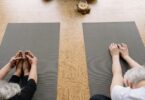Yoga has been proven to provide numerous physical and mental health benefits, but these benefits are not limited to those living outside of correctional facilities. Yoga can be an effective tool in the rehabilitation and reintegration of older adults in prison. This guide will discuss the benefits of yoga for older adults in prison and the challenges of implementing yoga programs in correctional facilities.
Benefits of Yoga for Older Adults in Prison
Yoga can provide many benefits to older adults in prison, including physical benefits such as improved flexibility and balance, and mental health benefits such as reduced stress and anxiety. Here are a few specific benefits that older adults in prison may experience from practicing yoga:
- Improved physical health: Yoga poses can help improve flexibility, balance, and strength, which can be especially beneficial for older adults who may have limited mobility.
- Reduced stress and anxiety: Yoga promotes relaxation and mindfulness, which can help reduce stress and anxiety.
- Increased self-awareness and self-regulation: Yoga can help individuals become more aware of their thoughts, feelings, and bodily sensations, which can lead to better self-regulation.
Challenges of Implementing Yoga Programs in Correctional Facilities
Despite the benefits of yoga for older adults in prison, there can be challenges in implementing yoga programs in correctional facilities. Here are a few challenges that may arise:
- Limited space and resources: Correctional facilities may have limited space and resources, which can make it difficult to provide yoga classes.
- Safety concerns: Safety concerns may arise when providing yoga classes in a correctional setting.
- Resistance from correctional staff and older adults in prison: There may be resistance from correctional staff and older adults in prison to the idea of yoga, which can make it difficult to implement a program.
How to Implement Yoga Programs in Correctional Facilities
Despite the challenges, it is possible to implement yoga programs in correctional facilities. Here are a few tips for implementing a yoga program:
- Partner with organizations: Partnering with organizations that specialize in providing yoga to under-served populations can help provide resources and expertise.
- Start small: Starting with a small pilot program can help build support and demonstrate the benefits of yoga.
- Address safety concerns: Safety concerns can be addressed by providing training to correctional staff and older adults in prison on how to safely participate in yoga classes.
Conclusion
Yoga can provide many benefits to older adults in prison, but there can be challenges in implementing yoga programs in correctional facilities. Partnering with organizations, starting small, and addressing safety concerns can help overcome these challenges and bring the benefits of yoga to older adults in prison. Yoga can be an effective tool in the rehabilitation and reintegration of older adults in prison, helping them improve their physical and mental well-being, and ultimately become more successful in their reentry into society.







